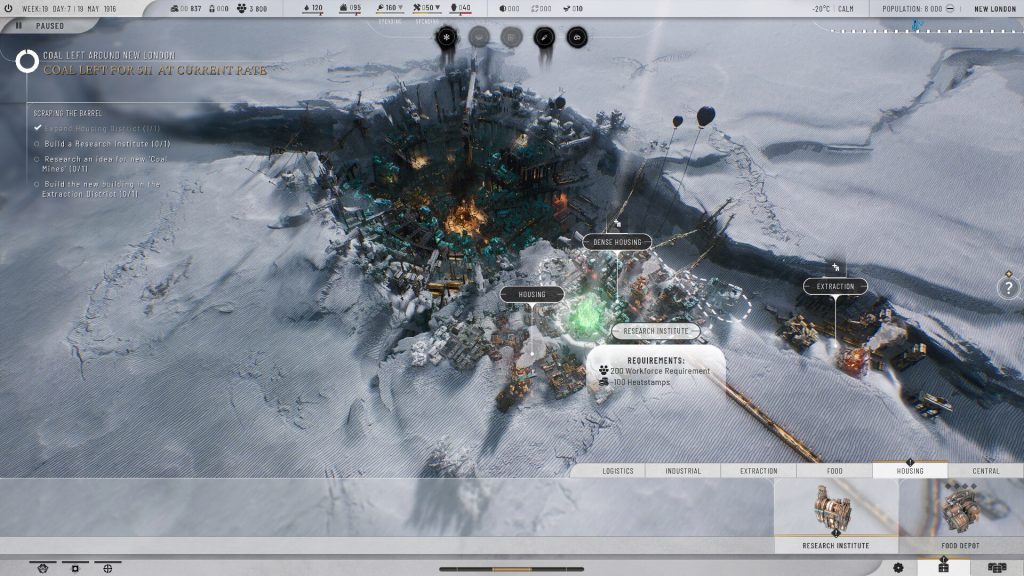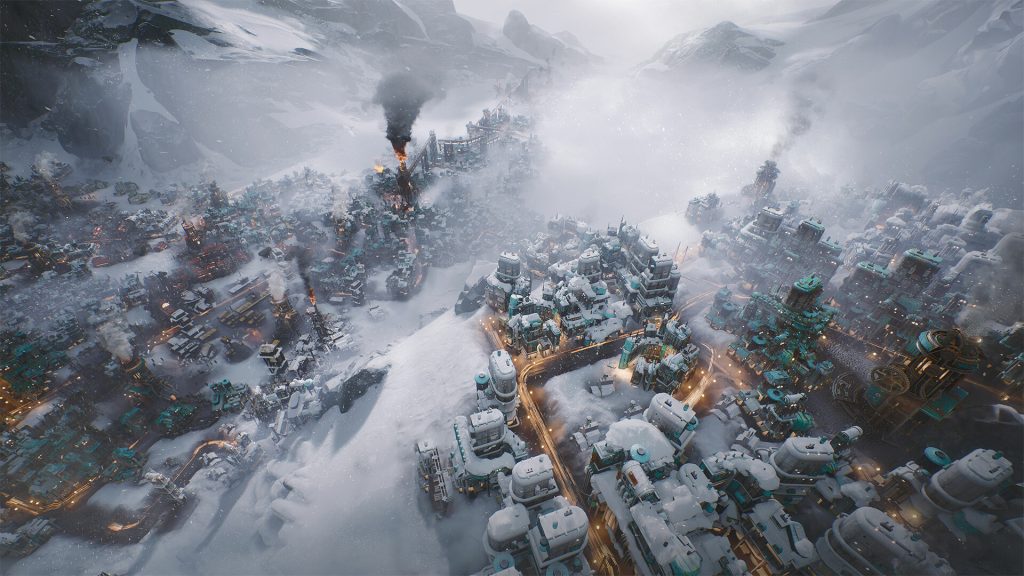
What happens when you survive the un-survivable?” This question lies at the heart of Frostpunk 2’s multi-layered structure. Frostpunk 2 is set 30 years after the events of the first game and society has finally found its feet. Everything about the game is expanded in scope from the first one, with a larger populace to deal with and city districts to manage. But scope isn’t the only difference between the games. Join us as we explore 15 of the biggest differences between Frostpunk 1 and Frostpunk 2.
The Age of Coal is Over
Set 30 years after Frostpunk 1, the expansive sequel replaces coal with oil as a more powerful heating resource. Frostpunk 2’s opening hours are spent using coal, but as demonstrated in the beta, this primitive resource fails to keep the generator going for long. As such, one of the beta’s multiple endings involves the discovery of an oil colony. Oil’s role in gameplay terms is getting the city to thrive instead of just surviving the cold, resulting in a city that can expand far beyond its generator. It’s clear that the dev team is saving the finer details of oil’s role for release.
Build and Manage Entire Districts Instead of Just Buildings

With oil comes great responsibility, and that means a bigger city. Frostpunk 1 focused more on the intimate hub surrounding the all-important generator. Things were much smaller in scale in the coal days, with a single building marking a substantial addition. Now, players can expand their city into different districts. Each district in Frostpunk 2 fulfills a unique production role. A housing district will require different resources than a food district, supplying you with distinct advantages. Supply and demand fuel the economics of Frostpunk 2, a change from the brutal ‘scraping to survive’ economics that the first game necessitated.
You’re No Longer the Sole Dictator
Frostpunk 2 has you negotiating with leaders to pass laws through a democratic Council Hall. The Council Hall adds a deep new diplomatic layer to the game, tying together the new faction system with it. Proposing a new law is often met with stern resistance from committee members, forcing the player to negotiate with them and pressure delegates. Your relationships with factions will be strained if you negotiate too forcefully with them. Factions are a complex new wrinkle deserving of their own entry on this list.
Different Competing Factions

Upon starting up a new game, you’re met with the option to choose between different Communities to populate your city. Worker communities prioritize different values and resources than thinker communities, with each eventually developing into full-fledged factions. Factions come into play through the Council Hall negotiations and the research of new buildings and technologies. For example, faction-exclusive research comes at a discount if you are on good terms with that particular faction. Get on bad terms with workers or the technocrat faction and they could work against you in Council Hall sessions and make it harder to research certain buildings.
Time Is Measured in Weeks Instead of Days
Frostpunk 2 moves along at a brisker pace than its predecessor, literally. The in-game clock now includes week, month, and year indicators. Days pass by in literal minutes, and the visuals indicate as much. Roads between the connected districts are lit by the blurred outline of swift-moving citizens, reminiscent of time-lapse car lights. This zoomed-out perspective of in-game time is just one manifestation of Frostpunk 2’s expanded scope.
Frostpunk 2 Uses Unreal Engine 5 While Frostpunk 1 Used Liquid Engine
Frostpunk 1 doesn’t look ugly by any stretch of the imagination, but wow does the sequel outshine it in the graphics department. Lighting in particular really pops due to the high contrast Lumen tech facilitated by UE5. The team does a good job differentiating terrain to make everything look organic and rugged in Frostpunk 2, which is just further helped by the capabilities of Unreal Engine 5.
Hexagonal Grid Tiles
Surprisingly enough, Frostpunk 1 didn’t have grid-based building placement. It didn’t need it due to the micro-scale it was operating on. But now with comprehensive districts connected by long roads, grids are a necessity. Empty land spaces are divvied up by hexagonal tiles, but once you build on the land, a wider grid outline surrounds your property. This is a small, yet vital addition that accommodates Frostpunk 2’s larger scope.
Frostbreaking

Extracting coal and ore deposits in the frozen wastes beyond the city is no simple feat. Unlike the first game, you must send Frostbreaker teams to break the ice before building on the tiles and extracting materials. Frostbreaking may seem like unnecessary busywork, but it allows you to expand the city limits far beyond anything dreamt of in the first game. You can stretch the city out far into the distance … if you can keep up with the resource demand, that is.
Relations, Tension, and Trust Replace Discontent and Hope Social Resources
Frostpunk 2 builds upon the first game’s social resources with Relations, Tension, and Trust. All three of these resources tie into the substantial role that factions and communities play. How other faction groups perceive you replace the brutal survival-oriented problems faced in the first game.
New Crime and Squalor Resource Tabs
Crime increases as goods become more scarce, as you’d expect. You can mitigate increased crime by posting Guard Squads around the districts, but a general population increase leads to a rise in crime. Likewise, Squalor worsens as the population increases, resulting in a dirtier, more disease-addled city. Making sure you balance city expansion with resources to counterbalance the increased population looks to be a fun challenge in Frostpunk 2.
A Population of Thousands Rather Than Hundreds

And of course, the reason we have new Squalor and Crime resources is due to Frostpunk 2’s much larger population. Micromanaging a sub-hundred population in Frostpunk 1 required sophisticated micromanagement skills, while the sequel requires you to multitask across multiple social vectors and resources to satiate the masses.
From Micro to Macro
This shift from micro to macro is a pretty substantial one. I can’t help but think that there’s an element of intimacy and familiarity that is lost when managing a multi-district city. This macro-scale approach will undoubtedly rope in new players averse to the first game’s micromanagement. But the broader scale also makes Frostpunk 2 a little bit less niche and more akin to other city-builder games. While there are still micromanagement elements present in Frostpunk 2, the zoomed-out perspective emphasizes the macro far more.
Far Different Moral Dilemmas
Moral dilemmas in Frostpunk 2 mostly show themselves when deciding which Faction you want to partner with and what suggestions to prioritize. Getting a law passed that bans food additives isn’t as black and white of a moral decision as boosting labor for a couple of weeks to stave off the cold. The moral dilemmas presented in Frostpunk 2 may be less dramatic than in the first game, but they’re more nuanced and politically driven.
Shift From Survival Management to Social Management
Frostpunk 2’s creative director perfectly summed up the game’s premise with the question, “What happens when you survive the un-survivable?” Every system in the game reflects this shift from basic survival to societal evolution. From the laws passed at Council Hall to all the different Factions at play, Frostpunk 2 focuses more on social management than survival management.
You Play as the Steward, Replacing the Deceased Captain
Finally, there’s us, the player. We played the role of the Captain back in the first game. We held the responsibility as a lone dictator, in a sense, with little to no opposition but the deathly cold and riotous populace. Your role in Frostpunk 2 is still a major one, though there’s a lot more teamwork and negotiations with other leaders this time around. The Steward is still a big fish, but the pond is much bigger than the first game, making it a more diplomatic affair overall. We’ll see just how much we, as the Steward, can get away with when Frostpunk 2 releases on September 20th.














